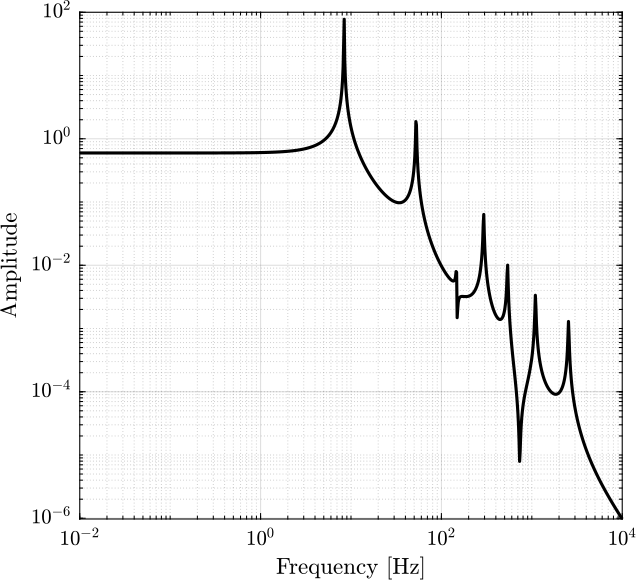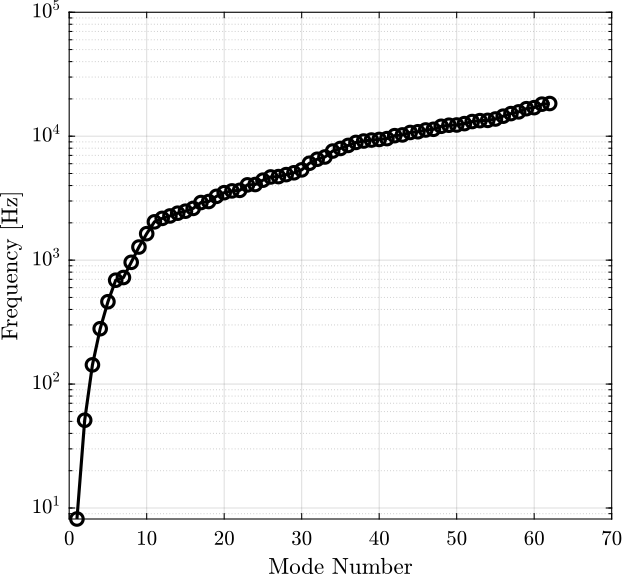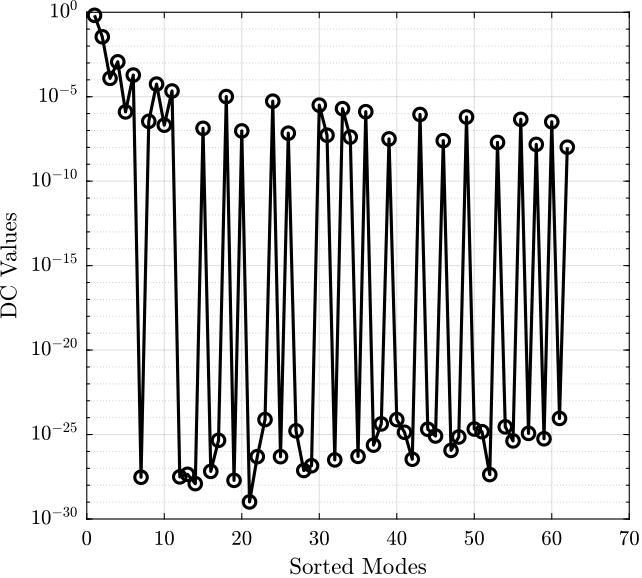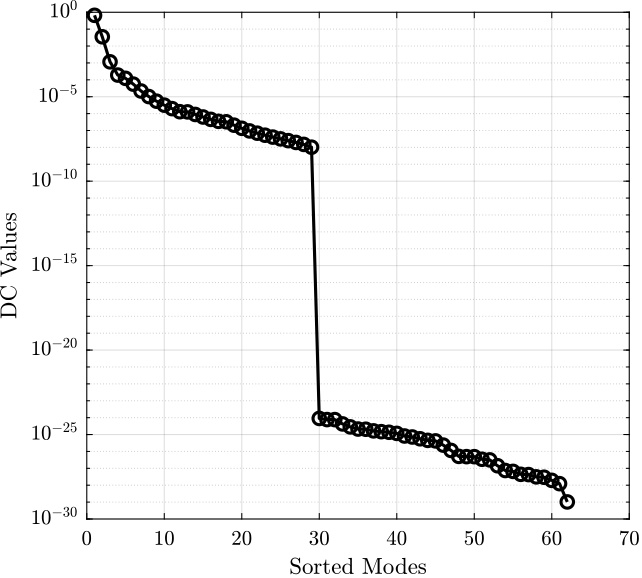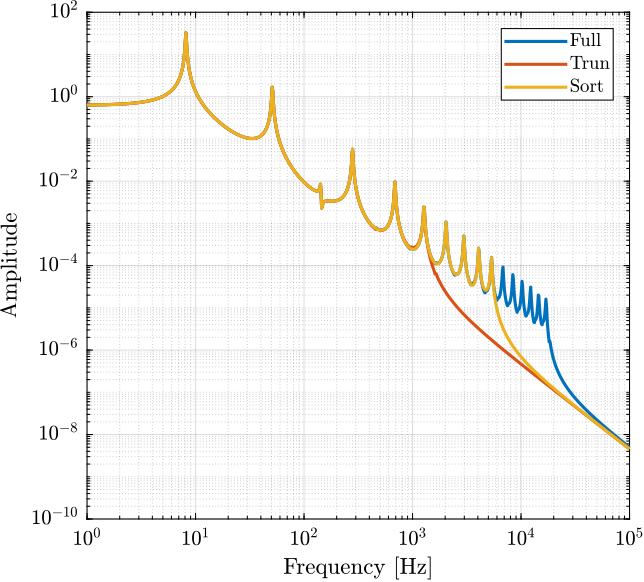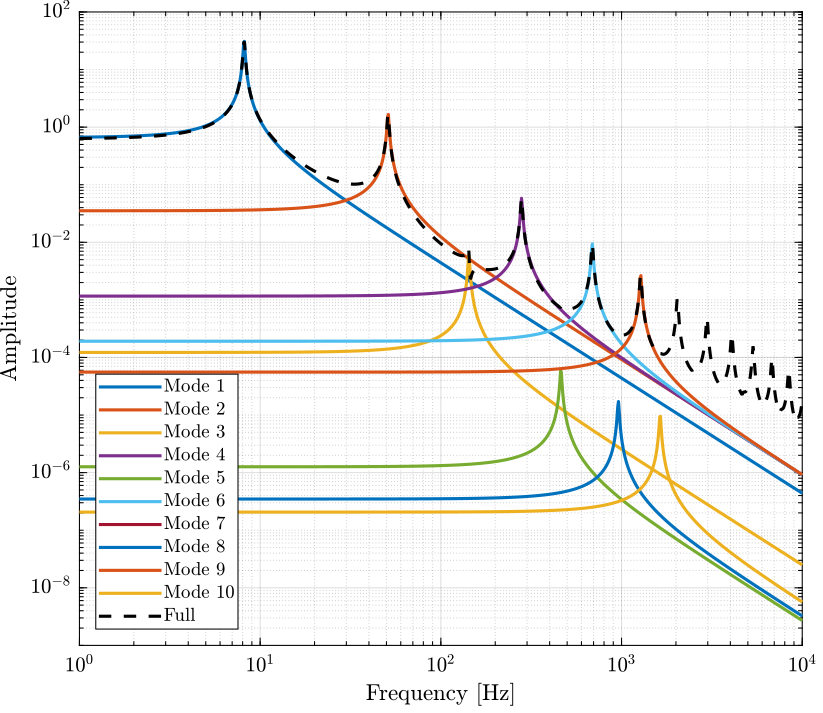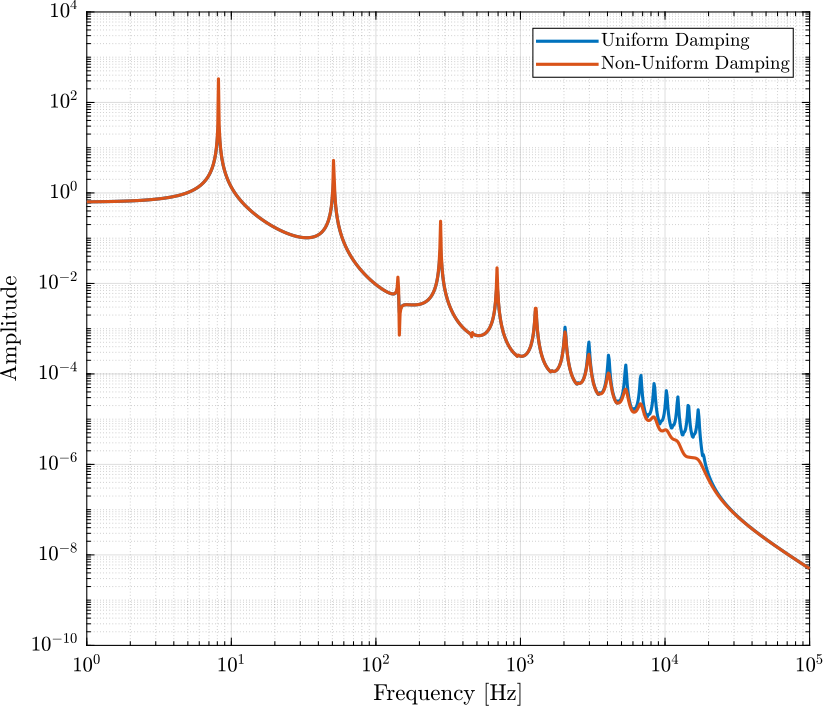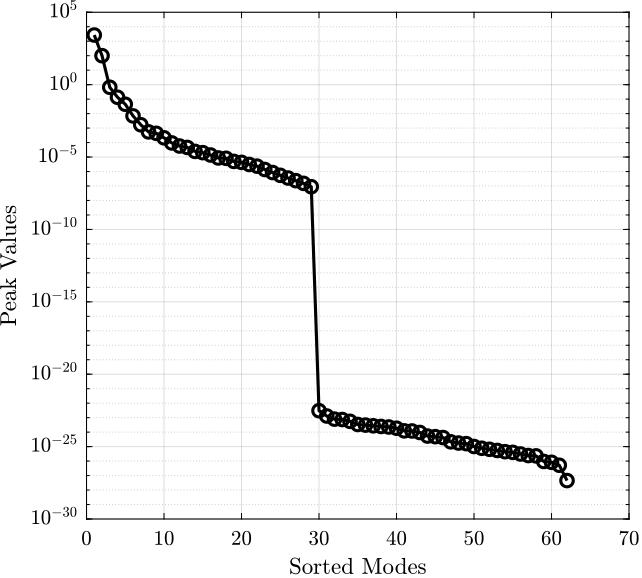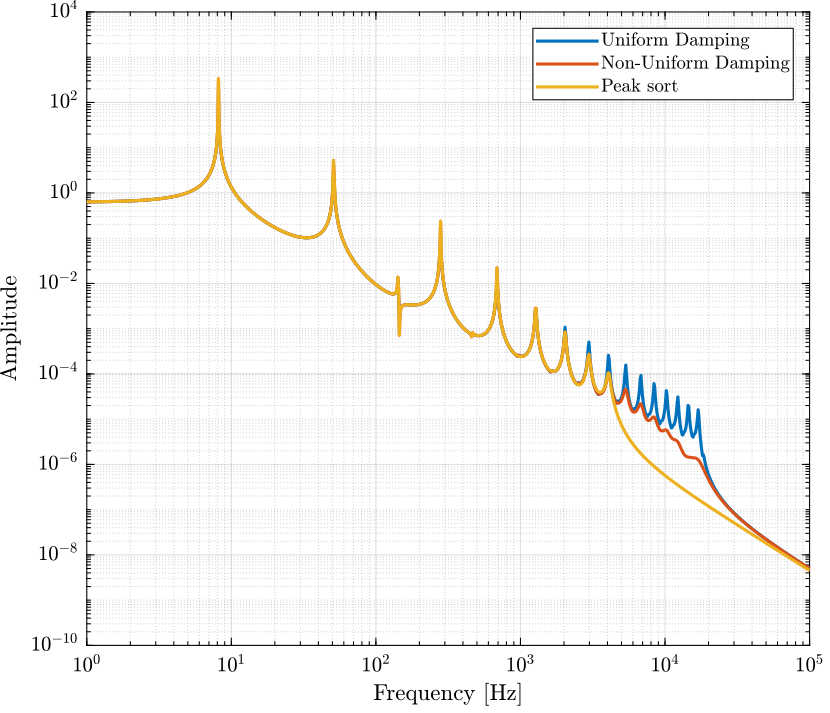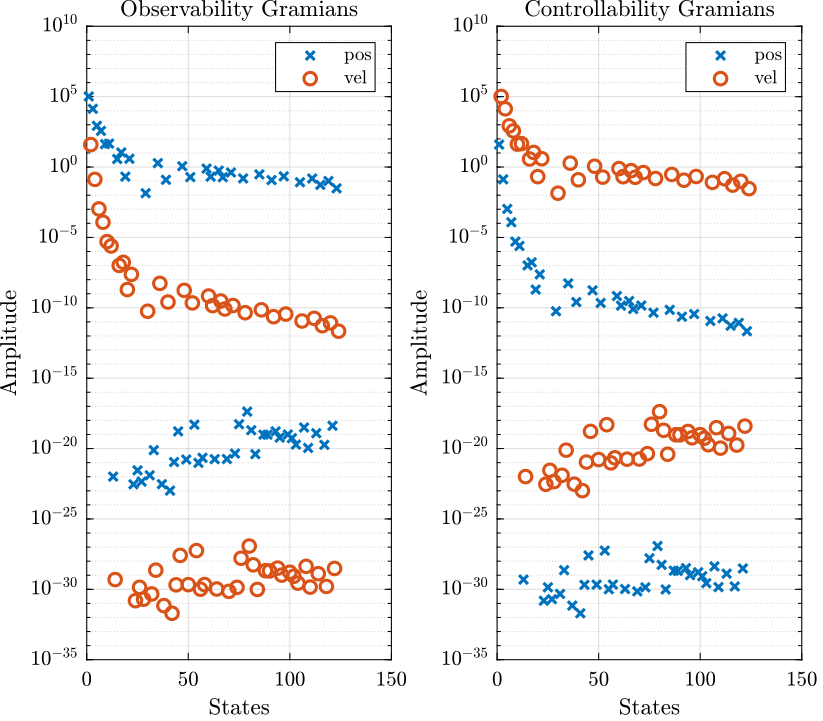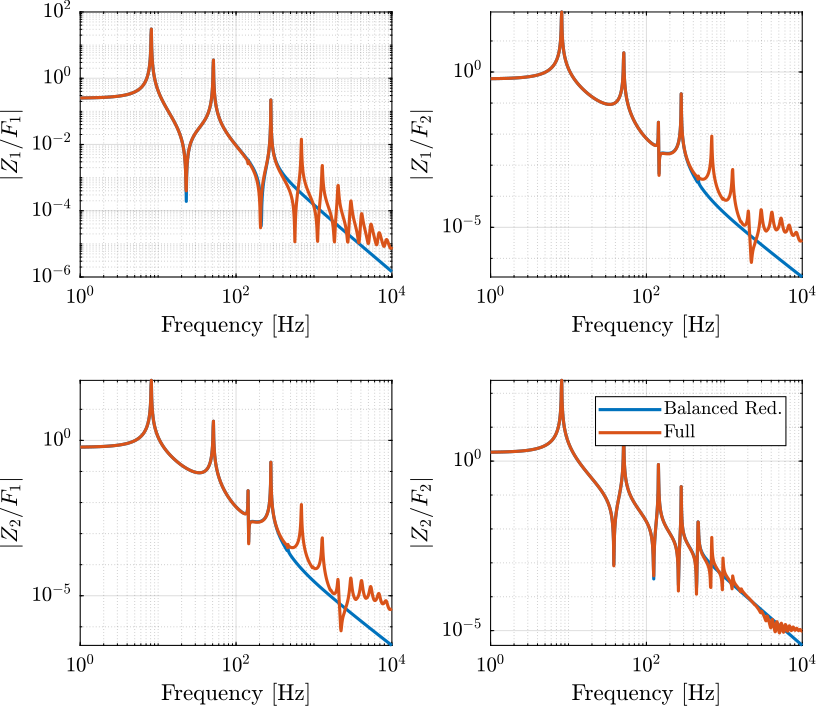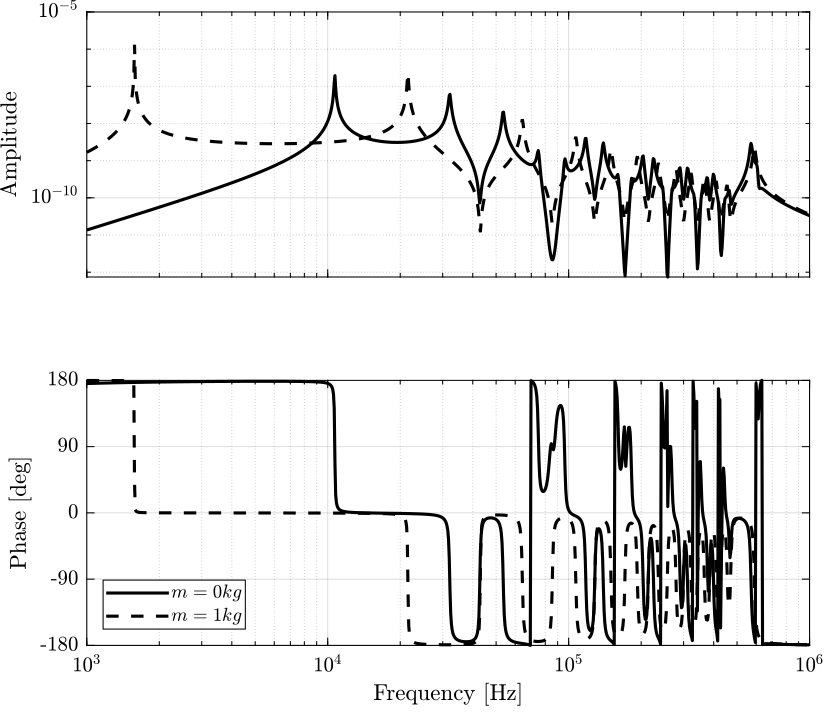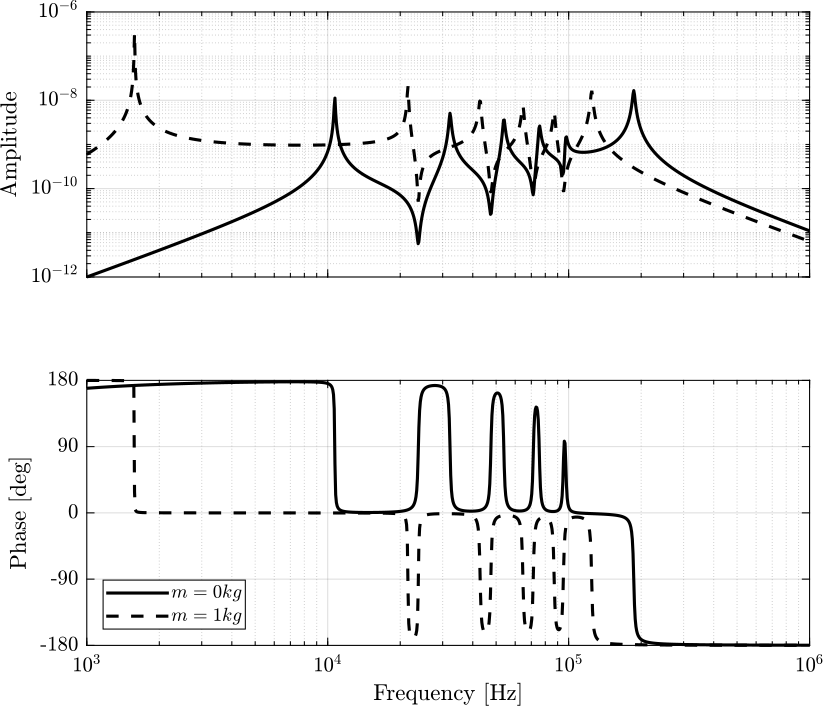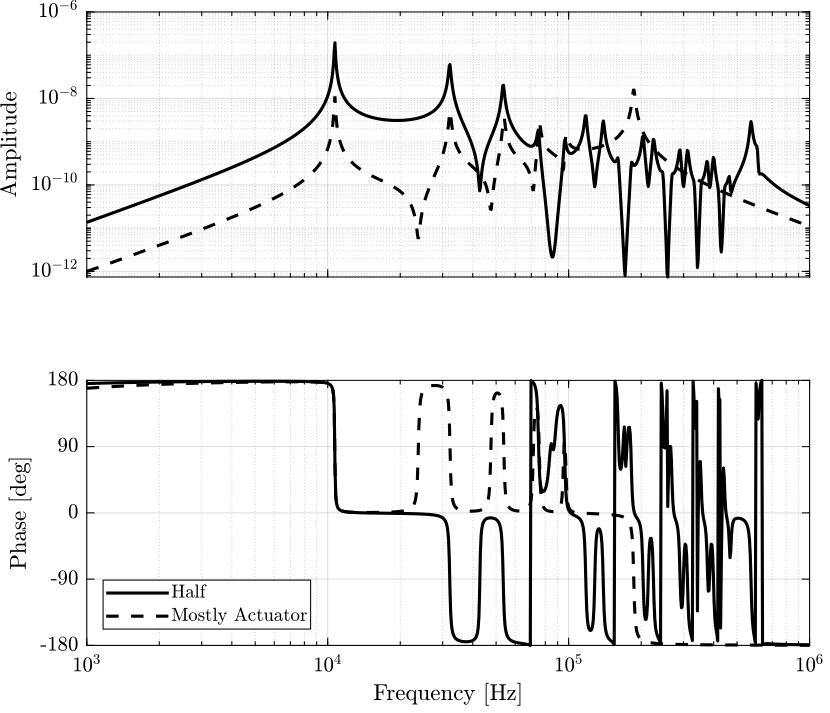This small toolbox provides a set of functions to help using flexible elements on Simscape from a Finite Element Software.
The functions are all described in section sec:functions.
Few examples are provided in the following sections.
In this section, we wish to model a simple flexible cantilever beam using Simscape.
The cantilever beam is first defined in Ansys. The reduced Mass and Stiffness matrices are then exported using the Component Mode Synthesis.
The coordinates of interface nodes (nodes where forces can be applied, displacements measured, and connections with other elements) are also exported.
First, these information are imported in Matlab, and then are used in Simscape to model the flexible element.
addpath('./src/');
addpath('examples/cant_beam/');We first extract the stiffness matrix.
K = extractMatrix('cant_beam_K.txt');| 42000.0 | 0.0 | 0.0 | 0.0 | 0.0 | 0.0 | -42000.0 | 0.0 | 0.0 | 0.0 |
| 0.0 | 17.0 | 0.0 | 0.0 | 0.0 | 4200.0 | 0.0 | -17.0 | 0.0 | 0.0 |
| 0.0 | 0.0 | 17.0 | 0.0 | -4200.0 | 0.0 | 0.0 | 0.0 | -17.0 | 0.0 |
| 0.0 | 0.0 | 0.0 | 230000.0 | 0.0 | 0.0 | 0.0 | 0.0 | 0.0 | -230000.0 |
| 0.0 | 0.0 | -4200.0 | 0.0 | 1400000.0 | 0.0 | 0.0 | 0.0 | 4200.0 | 0.0 |
| 0.0 | 4200.0 | 0.0 | 0.0 | 0.0 | 1400000.0 | 0.0 | -4200.0 | 0.0 | 0.0 |
| -42000.0 | 0.0 | 0.0 | 0.0 | 0.0 | 0.0 | 84000.0 | 0.0 | 0.0 | 0.0 |
| 0.0 | -17.0 | 0.0 | 0.0 | 0.0 | -4200.0 | 0.0 | 34.0 | 0.0 | 0.0 |
| 0.0 | 0.0 | -17.0 | 0.0 | 4200.0 | 0.0 | 0.0 | 0.0 | 34.0 | 0.0 |
| 0.0 | 0.0 | 0.0 | -230000.0 | 0.0 | 0.0 | 0.0 | 0.0 | 0.0 | 460000.0 |
M = extractMatrix('cant_beam_M.txt');| 0.00013 | 0.0 | 0.0 | 0.0 | 0.0 | 0.0 | 6.5e-05 | 0.0 | 0.0 | 0.0 |
| 0.0 | 0.00014 | 0.0 | 0.0 | 0.0 | 0.01 | 0.0 | 5e-05 | 0.0 | 0.0 |
| 0.0 | 0.0 | 0.00014 | 0.0 | -0.01 | 0.0 | 0.0 | 0.0 | 5e-05 | 0.0 |
| 0.0 | 0.0 | 0.0 | 0.0022 | 0.0 | 0.0 | 0.0 | 0.0 | 0.0 | 0.0011 |
| 0.0 | 0.0 | -0.01 | 0.0 | 0.93 | 0.0 | 0.0 | 0.0 | -0.006 | 0.0 |
| 0.0 | 0.01 | 0.0 | 0.0 | 0.0 | 0.93 | 0.0 | 0.006 | 0.0 | 0.0 |
| 6.5e-05 | 0.0 | 0.0 | 0.0 | 0.0 | 0.0 | 0.00026 | 0.0 | 0.0 | 0.0 |
| 0.0 | 5e-05 | 0.0 | 0.0 | 0.0 | 0.006 | 0.0 | 0.00029 | 0.0 | 0.0 |
| 0.0 | 0.0 | 5e-05 | 0.0 | -0.006 | 0.0 | 0.0 | 0.0 | 0.00029 | 0.0 |
| 0.0 | 0.0 | 0.0 | 0.0011 | 0.0 | 0.0 | 0.0 | 0.0 | 0.0 | 0.0043 |
Then, we extract the coordinates of the interface nodes.
[int_xyz, int_i] = extractNodes('cant_beam.txt');| Node Number | x | y | z |
|---|---|---|---|
| 1 | 0 | 0 | 0 |
| 6 | 500 | 0 | 0 |
| 22 | 1000 | 0 | 0 |
Using K, M and int_xyz, we can use the Reduced Order Flexible Solid simscape block.
The flexible element is imported using the Reduced Order Flexible Solid simscape block.
The beginning of the cantilever beam is fixed to the World frame, a force actuator is added in the z direction on the middle node, and a z-displacement sensor is added at the end of the beam.
The dynamics is identified from the applied force to the measured displacement (Figure fig:cant_beam_frf).
%% Name of the Simulink File
mdl = 'cant_beam';
%% Input/Output definition
clear io; io_i = 1;
io(io_i) = linio([mdl, '/F'], 1, 'openinput'); io_i = io_i + 1;
io(io_i) = linio([mdl, '/z'], 1, 'openoutput'); io_i = io_i + 1;
G = linearize(mdl, io);Most of the example presented in this section are taken from cite:hatch00_vibrat_matlab_ansys.
The goal is to obtain a low order model from a Finite Element Model.
We suppose here that the eigenvalues and eigenvectors are exported using a Finite Element software.
Once the eigenvalues and eigenvectors are imported, one should choose the inputs and outputs nodes (e.g. where the forces and the displacements are measured) to first reduce the number of eigenvectors.
Damping can then be added to each.
Then, in order to reduce the size of the model, only few modes are included in the model. The selection of the modes to keep in the model can be based on the “dc gain” or “peak gain” method depending on the damping.
Finally, the full model and reduced models are compared.
addpath('./src/');
addpath('examples/cant_beam_ansys/');The eigenvalues and eigenvectors are extracted.
[xn, f0] = extractEigs('cantbeam30bl.eig', 'dirs', [1 0 0 0 0 0]');
n_nodes = size(xn, 1);
n_modes = size(xn, 2);First, define the node numbers corresponding to the inputs and outputs
i_input = 14; % middle of the beam
i_output = 29; % end of the beamWe here use uniform damping.
xi = 0.01;The state space matrices are created by “inspection”. Here, we include all the modes.
System Matrix - A
Adiag = zeros(2*n_modes,1);
Adiag(2:2:end) = -2*xi.*(2*pi*f0);
Adiagsup = zeros(2*n_modes-1,1);
Adiagsup(1:2:end) = 1;
Adiaginf = zeros(2*n_modes-1,1);
Adiaginf(1:2:end) = -(2*pi*f0).^2;
A = diag(Adiag) + diag(Adiagsup, 1) + diag(Adiaginf, -1);System Matrix - B
B = zeros(2*n_modes, length(i_input));
for i = 1:length(i_input)
% Physical Coordinates
Fp = zeros(n_nodes, 1);
Fp(i_input(i)) = 1;
B(2:2:end, i) = xn'*Fp;
endSystem Matrix - C
C = zeros(length(i_output), 2*n_modes);
C(:, 1:2:end) = xn(i_output, :);System Matrix - D
D = zeros(length(i_output), length(i_input));State Space Model
G_f = ss(A, B, C, D);Let see what happens is we simply truncate the number of modes (keeping only the low frequency modes).
The frequency of the modes are shown in Figure fig:hatch00_cant_beam_modes_freq.
The DC gain of each mode is shown in Figure fig:hatch00_cant_beam_unsorted_dc_gains.
Let’s keep only the first 10 modes.
m_max = 10;
xn_t = xn(:, 1:m_max);
f0_t = f0(1:m_max);And create the state space model with the kept modes:
Let’s sort the modes by their DC gains and plot their sorted DC gains (Figure fig:hatch00_cant_beam_sorted_dc_gains).
dc_gain = abs(xn(i_input, :).*xn(i_output, :))./(2*pi*f0).^2;
[dc_gain_sort, index_sort] = sort(dc_gain, 'descend');Let’s keep only the first 10 sorted modes.
m_max = 10;
xn_s = xn(:, index_sort(1:m_max));
f0_s = f0(index_sort(1:m_max));And create the state space model with the kept modes:
G_s = ss(A, B, C, D);The following models are compared on Figure fig:cant_beam_comp_reduc_techniques:
- full model containing all the modes
- the truncated model containing only the low frequency modes
- the model where modes are sorted based on DC gain before selection
One can see that with the same number of modes, the sorted model gives much better results than the truncated one.
To see why it is better to sort the modes prior mode reduction, we can look at the contribution of the individual modes as shown in Figure fig:cant_beam_individial_modes.
One can see that some modes have no effect on the dynamics for the selected inputs and outputs.
freqs = logspace(0, 4, 1000);
figure;
hold on;
for mode_i = 1:10
A = zeros(2);
A(2,2) = -2*xi.*(2*pi*f0(mode_i));
A(1,2) = 1;
A(2,1) = -(2*pi*f0(mode_i)).^2;
B = [0; xn(i_input, mode_i)'];
C = [xn(i_output, mode_i), 0];
D = zeros(length(i_output), length(i_input));
plot(freqs, abs(squeeze(freqresp(ss(A,B,C,D), freqs, 'Hz'))), ...
'DisplayName', sprintf('Mode %i', mode_i));
end
plot(freqs, abs(squeeze(freqresp(G_f, freqs, 'Hz'))), 'k--', ...
'DisplayName', 'Full');
set(gca, 'XScale', 'log'); set(gca, 'YScale', 'log');
ylabel('Amplitude'); xlabel('Frequency [Hz]');
ylim([1e-9, 1e2]);
legend('location', 'southwest');Let’s say we want to use Rayleigh damping: \begin{equation} ξ_i = \frac{a + b ω_i^2}{ω_i} \end{equation}
We define the parameters on Matlab:
a = 1e-2;
b = 1e-6;
xi = (a + b * (2*pi*f0).^2)./(2*pi*f0);And we can create the state space model.
System Matrix - A
Adiag = zeros(2*n_modes,1);
Adiag(2:2:end) = -2*xi.*(2*pi*f0);
Adiagsup = zeros(2*n_modes-1,1);
Adiagsup(1:2:end) = 1;
Adiaginf = zeros(2*n_modes-1,1);
Adiaginf(1:2:end) = -(2*pi*f0).^2;
A = diag(Adiag) + diag(Adiagsup, 1) + diag(Adiaginf, -1);System Matrix - B
B = zeros(2*n_modes, length(i_input));
for i = 1:length(i_input)
% Physical Coordinates
Fp = zeros(n_nodes, 1);
Fp(i_input(i)) = 1;
B(2:2:end, i) = xn'*Fp;
endSystem Matrix - C
C = zeros(length(i_output), 2*n_modes);
C(:, 1:2:end) = xn(i_output, :);System Matrix - D
D = zeros(length(i_output), length(i_input));State Space Model
G_d = ss(A, B, C, D);And we compare the obtained dynamics when using Uniform Damping (Figure fig:cant_beam_comp_unif_non_unif_damp).
The modes are sorted by their peak gain. The obtained sorted peak gains for each mode are shown in figure fig:cant_beam_peak_gains_sorted.
dc_gain = abs(xn(i_input, :).*xn(i_output, :))./(2*pi*f0).^2;
peak_gain = dc_gain./xi;
[peak_gain_sort, index_sort] = sort(peak_gain, 'descend');Let’s keep only the first 10 sorted modes.
m_max = 10;
xn_s = xn(:, index_sort(1:m_max));
f0_s = f0(index_sort(1:m_max));
xi_s = xi(index_sort(1:m_max));And we create the state space matrices.
Adiag = zeros(2*m_max,1);
Adiag(2:2:end) = -2*xi_s.*(2*pi*f0_s);
Adiagsup = zeros(2*m_max-1,1);
Adiagsup(1:2:end) = 1;
Adiaginf = zeros(2*m_max-1,1);
Adiaginf(1:2:end) = -(2*pi*f0_s).^2;
A = diag(Adiag) + diag(Adiagsup, 1) + diag(Adiaginf, -1);B = zeros(2*m_max, length(i_input));
for i = 1:length(i_input)
% Physical Coordinates
Fp = zeros(n_nodes, 1);
Fp(i_input(i)) = 1;
B(2:2:end, i) = xn_s'*Fp;
endC = zeros(length(i_output), 2*m_max);
C(:, 1:2:end) = xn_s(i_output, :);D = zeros(length(i_output), length(i_input));And finally the reduced State Space Model is created and compared with the full model in Figure fig:cant_beam_non_uniform_damp_reduced_dynamics.
G_p = ss(A, B, C, D);When using multiple inputs and multiple outputs, one cannot simply choose the modes to keep based on their gains because this gain depends on the inputs and outputs chosen.
In such case, balancing reduction should be used.
Let’s choose two inputs and two outputs.
i_input = [14, 31];
i_output = [14, 31];The state space matrices are created by inspection.
Adiag = zeros(2*n_modes,1);
Adiag(2:2:end) = -2*xi.*(2*pi*f0);
Adiagsup = zeros(2*n_modes-1,1);
Adiagsup(1:2:end) = 1;
Adiaginf = zeros(2*n_modes-1,1);
Adiaginf(1:2:end) = -(2*pi*f0).^2;
A = diag(Adiag) + diag(Adiagsup, 1) + diag(Adiaginf, -1);B = zeros(2*n_modes, length(i_input));
for i = 1:length(i_input)
% Physical Coordinates
Fp = zeros(n_nodes, 1);
Fp(i_input(i)) = 1;
B(2:2:end, i) = xn'*Fp;
endC = zeros(length(i_output), 2*n_modes);
C(:, 1:2:end) = xn(i_output, :);D = zeros(length(i_output), length(i_input));And the State Space Model is created.
G_m = ss(A, B, C, D);First, we have to make sure that the rigid body mode is not included in the system (here it is not).
Then, we compute the controllability and observability gramians.
wc = gram(G_m, 'c');
wo = gram(G_m, 'o');And we plot the diagonal terms of the controllability and observability gramians (Figure fig:cant_beam_gramians). The states representing the position and velocity are separated.
We use balreal to rank oscillatory states.
[SYSB,G] = BALREAL(SYS) computes a balanced state-space realization for the stable portion of the linear system SYS. For stable systems, SYSB is an equivalent realization for which the controllability and observability Gramians are equal and diagonal, their diagonal entries forming the vector G of Hankel singular values. Small entries in G indicate states that can be removed to simplify the model (use MODRED to reduce the model order).
[G_b, G, T, Ti] = balreal(G_m);The diagonal values of the two gramians are shown in Figure fig:cant_beam_gramian_balanced.
Now we can choose the number of states to keep.
n_states_b = 10;We now use modred to define reduced order oscillatory system using mathdc or truncate option.
MODRED Model simplification by state elimination.
RSYS = MODRED(SYS,ELIM) simplifies the state-space model SYS by discarding the states specified in the vector ELIM. The full state vector X is partitioned as X = [X1;X2] where Xr=X1 is the reduced state vector and X2 is discarded.
G_br = modred(G_b, n_states_b+1:size(A,1), 'truncate');If needed, the rigid body mode should be added to the reduced system.
And other option is to specify the minimum value of the gramians diagonal elements for the modes to keep.
G_min = 1e-4;
G_br = modred(G_b, G<G_min, 'truncate');The obtained reduced dynamics is shown in Figure fig:cant_beam_mimo_reduction.
addpath('./src/');
addpath('examples/piezo_stack/');We first extract the stiffness and mass matrices.
K = extractMatrix('piezo_stack_half_K.txt');
M = extractMatrix('piezo_stack_half_M.txt');Then, we extract the coordinates of the interface nodes.
[int_xyz, int_i, n_xyz, n_i, nodes] = extractNodes('piezo_stack_half.txt');| Total number of Nodes | 1404 |
| Number of interface Nodes | 3 |
| Number of Modes | 186 |
| Size of M and K matrices | 204 |
| Node Number | x [m] | y [m] | z [m] |
|---|---|---|---|
| 1402.0 | 0.0 | 0.0 | 0.0 |
| 1403.0 | 0.035 | 0.0 | 0.0 |
| 1404.0 | 0.07 | 0.0 | 0.0 |
| 200000000.0 | 0 | 0 | 0 | 0 | 0 | -200000000.0 | 0 | 0 | 0 |
| 0 | 10000000.0 | 0 | 0 | 0 | 200000.0 | 0 | -10000000.0 | 0 | 0 |
| 0 | 0 | 10000000.0 | 8e-06 | -200000.0 | 0 | 0 | 0 | -10000000.0 | 4e-06 |
| 0 | 0 | 8e-06 | 1000.0 | -4e-08 | 0 | 0 | 0 | 4e-06 | -1000.0 |
| 0 | 0 | -200000.0 | -4e-08 | 6000.0 | 0 | 0 | 0 | 200000.0 | -3e-08 |
| 0 | 200000.0 | 0 | 0 | 0 | 6000.0 | 0 | -200000.0 | 0 | 0 |
| -200000000.0 | 0 | 0 | 0 | 0 | 0 | 400000000.0 | 0 | 0 | 0 |
| 0 | -10000000.0 | 0 | 0 | 0 | -200000.0 | 0 | 30000000.0 | 0 | 0 |
| 0 | 0 | -10000000.0 | 4e-06 | 200000.0 | 0 | 0 | 0 | 30000000.0 | 2e-05 |
| 0 | 0 | 4e-06 | -1000.0 | -3e-08 | 0 | 0 | 0 | 2e-05 | 2000.0 |
| 0.009 | 0 | 0 | 0 | 0 | 0 | 0.005 | 0 | 0 | 0 |
| 0 | 0.01 | 0 | 0 | 0 | 5e-05 | 0 | 0.004 | 0 | 0 |
| 0 | 0 | 0.01 | -6e-16 | -5e-05 | 0 | 0 | 0 | 0.004 | -5e-16 |
| 0 | 0 | -6e-16 | 2e-07 | 4e-18 | 0 | 0 | 0 | -5e-16 | 8e-08 |
| 0 | 0 | -5e-05 | 4e-18 | 3e-07 | 0 | 0 | 0 | -3e-05 | 4e-18 |
| 0 | 5e-05 | 0 | 0 | 0 | 3e-07 | 0 | 3e-05 | 0 | 0 |
| 0.005 | 0 | 0 | 0 | 0 | 0 | 0.02 | 0 | 0 | 0 |
| 0 | 0.004 | 0 | 0 | 0 | 3e-05 | 0 | 0.02 | 0 | 0 |
| 0 | 0 | 0.004 | -5e-16 | -3e-05 | 0 | 0 | 0 | 0.02 | -1e-15 |
| 0 | 0 | -5e-16 | 8e-08 | 4e-18 | 0 | 0 | 0 | -1e-15 | 3e-07 |
Using K, M and int_xyz, we can use the Reduced Order Flexible Solid simscape block.
The flexible element is imported using the Reduced Order Flexible Solid simscape block.
To model the actuator, an Internal Force block is added between the first and second nodes.
To model the sensors, a Relative Motion Sensor block is added between the second and the third nodes.
Two masses are fixed at the ends of the piezo-electric stack actuator.
We first set the mass to be zero.
m = 0;The dynamics is identified from the applied force to the measured relative displacement.
%% Name of the Simulink File
mdl = 'piezo_stack';
%% Input/Output definition
clear io; io_i = 1;
io(io_i) = linio([mdl, '/F'], 1, 'openinput'); io_i = io_i + 1;
io(io_i) = linio([mdl, '/x'], 1, 'openoutput'); io_i = io_i + 1;
Gh = linearize(mdl, io);Then, we add 1Kg of mass:
m = 1;And the dynamics is identified.
The two identified dynamics are compared in Figure fig:piezo_stack_half_frf.
We first extract the stiffness and mass matrices.
K = extractMatrix('piezo_stack_actuator_K.txt');
M = extractMatrix('piezo_stack_actuator_M.txt');Then, we extract the coordinates of the interface nodes.
[int_xyz, int_i, n_xyz, n_i, nodes] = extractNodes('piezo_stack_actuator.txt');| Total number of Nodes | 1401 |
| Number of interface Nodes | 3 |
| Number of Modes | 30 |
| Size of M and K matrices | 48 |
| Node Number | x [m] | y [m] | z [m] |
|---|---|---|---|
| 1.0 | 0.0 | 0.0 | 0.0 |
| 2.0 | 0.06 | 0.0 | 0.0 |
| 3.0 | 0.07 | 0.0 | 0.0 |
| 110000000.0 | 0.0 | 0.0 | 0.0 | 0.0 | 0.0 | -110000000.0 | 0.0 | 0.0 | 0.0 |
| 0.0 | 2600000.0 | 0.0 | 1.3e-08 | 0.0 | 82000.0 | 0.0 | -2600000.0 | 0.0 | 0.0 |
| 0.0 | 0.0 | 2600000.0 | 1.5e-05 | -82000.0 | 0.0 | 0.0 | 0.0 | -2600000.0 | 6.5e-06 |
| 0.0 | 1.3e-08 | 1.5e-05 | 610.0 | -1.3e-07 | 6.3e-13 | 0.0 | 7.8e-13 | 6.5e-06 | -610.0 |
| 0.0 | 0.0 | -82000.0 | -1.3e-07 | 3500.0 | 0.0 | 0.0 | 0.0 | 82000.0 | -9.2e-08 |
| 0.0 | 82000.0 | 0.0 | 6.3e-13 | 0.0 | 3500.0 | 0.0 | -82000.0 | 0.0 | 0.0 |
| -110000000.0 | 0.0 | 0.0 | 0.0 | 0.0 | 0.0 | 1100000000.0 | 0.0 | 0.0 | 0.0 |
| 0.0 | -2600000.0 | 0.0 | 7.8e-13 | 0.0 | -82000.0 | 0.0 | 280000000.0 | 0.0 | 0.0 |
| 0.0 | 0.0 | -2600000.0 | 6.5e-06 | 82000.0 | 0.0 | 0.0 | 0.0 | 280000000.0 | 1.7e-05 |
| 0.0 | 0.0 | 6.5e-06 | -610.0 | -9.2e-08 | 0.0 | 0.0 | 0.0 | 1.7e-05 | 6100.0 |
| 0.016 | 0.0 | 0.0 | 0.0 | 0.0 | 0.0 | 0.0082 | 0.0 | 0.0 | 0.0 |
| 0.0 | 0.018 | 0.0 | -5.3e-21 | 0.0 | 0.00016 | 0.0 | 0.0064 | 0.0 | 0.0 |
| 0.0 | 0.0 | 0.018 | -5.9e-15 | -0.00016 | 0.0 | 0.0 | 0.0 | 0.0064 | -5.2e-15 |
| 0.0 | -5.3e-21 | -5.9e-15 | 2.7e-07 | 7.7e-17 | -4.7e-23 | 0.0 | -1.9e-21 | -5.2e-15 | 1.4e-07 |
| 0.0 | 0.0 | -0.00016 | 7.7e-17 | 1.9e-06 | 0.0 | 0.0 | 0.0 | -9.8e-05 | 7.2e-17 |
| 0.0 | 0.00016 | 0.0 | -4.7e-23 | 0.0 | 1.9e-06 | 0.0 | 9.8e-05 | 0.0 | 0.0 |
| 0.0082 | 0.0 | 0.0 | 0.0 | 0.0 | 0.0 | 0.018 | 0.0 | 0.0 | 0.0 |
| 0.0 | 0.0064 | 0.0 | -1.9e-21 | 0.0 | 9.8e-05 | 0.0 | 0.02 | 0.0 | 0.0 |
| 0.0 | 0.0 | 0.0064 | -5.2e-15 | -9.8e-05 | 0.0 | 0.0 | 0.0 | 0.02 | -5.9e-15 |
| 0.0 | 0.0 | -5.2e-15 | 1.4e-07 | 7.2e-17 | 0.0 | 0.0 | 0.0 | -5.9e-15 | 3e-07 |
Using K, M and int_xyz, we can use the Reduced Order Flexible Solid simscape block.
The flexible element is imported using the Reduced Order Flexible Solid simscape block.
To model the actuator, an Internal Force block is added between the first and second nodes.
To model the sensors, a Relative Motion Sensor block is added between the second and the third nodes.
Two masses are fixed at the ends of the piezo-electric stack actuator.
We first set the mass to be zero.
m = 0;The dynamics is identified from the applied force to the measured relative displacement.
%% Name of the Simulink File
mdl = 'piezo_stack';
%% Input/Output definition
clear io; io_i = 1;
io(io_i) = linio([mdl, '/F'], 1, 'openinput'); io_i = io_i + 1;
io(io_i) = linio([mdl, '/x'], 1, 'openoutput'); io_i = io_i + 1;
Ga = linearize(mdl, io);Then, we add 1Kg of mass:
m = 1;And the dynamics is identified.
K = extractMatrix('piezo_stack_actuator_bis_K.txt');
M = extractMatrix('piezo_stack_actuator_bis_M.txt');
[int_xyz, int_i, n_xyz, n_i, nodes] = extractNodes('piezo_stack_actuator_bis.txt');| Total number of Nodes | 1401 |
| Number of interface Nodes | 3 |
| Number of Modes | 120 |
| Size of M and K matrices | 138 |
m = 0;%% Name of the Simulink File
mdl = 'piezo_stack';
%% Input/Output definition
clear io; io_i = 1;
io(io_i) = linio([mdl, '/F'], 1, 'openinput'); io_i = io_i + 1;
io(io_i) = linio([mdl, '/x'], 1, 'openoutput'); io_i = io_i + 1;
Gb = linearize(mdl, io);m = 1;addpath('./src/');
addpath('examples/piezo_amplified/');We first extract the stiffness and mass matrices.
K = extractMatrix('piezo_amplified_K.txt');
M = extractMatrix('piezo_amplified_M.txt');Then, we extract the coordinates of the interface nodes.
[int_xyz, int_i, n_xyz, n_i, nodes] = extractNodes('piezo_amplified.txt');| Total number of Nodes | 14 |
| Number of interface Nodes | 13 |
| Number of Modes | 30 |
| Size of M and K matrices | 108 |
| Node i | Node Number | x [m] | y [m] | z [m] |
|---|---|---|---|---|
| 1.0 | 76423.0 | 0.0 | 0.03 | 0.0 |
| 2.0 | 76429.0 | 0.0 | -0.03 | 0.0 |
| 3.0 | 76430.0 | -0.035 | 0.0 | 0.0 |
| 4.0 | 76431.0 | 0.028 | 0.0 | 0.0 |
| 5.0 | 76432.0 | 0.021 | 0.0 | 0.0 |
| 6.0 | 76433.0 | 0.014 | 0.0 | 0.0 |
| 7.0 | 76434.0 | 0.007 | 0.0 | 0.0 |
| 8.0 | 76435.0 | 0.0 | 0.0 | 0.0 |
| 9.0 | 76436.0 | -0.007 | 0.0 | 0.0 |
| 10.0 | 76437.0 | -0.014 | 0.0 | 0.0 |
| 11.0 | 76438.0 | -0.021 | 0.0 | 0.0 |
| 12.0 | 76439.0 | -0.028 | 0.0 | 0.0 |
| 13.0 | 76440.0 | 0.035 | 0.0 | 0.0 |
| 200000000.0 | 30000.0 | -1000.0 | -4 | -70.0 | -80000.0 | 100000000.0 | 3000.0 | 1000.0 | -20.0 |
| 30000.0 | 80000000.0 | -1000.0 | 60.0 | 30.0 | -100.0 | -1000.0 | -40000000.0 | 3000.0 | 80.0 |
| -1000.0 | -1000.0 | 30000000.0 | -600000.0 | 20.0 | 6 | 4000.0 | 1000.0 | 10000000.0 | 100000.0 |
| -4 | 60.0 | -600000.0 | 20000.0 | -0.6 | -0.02 | -100.0 | 6 | -100000.0 | -1000.0 |
| -70.0 | 30.0 | 20.0 | -0.6 | 30000.0 | 0.2 | -50.0 | -200.0 | 6 | 0.07 |
| -80000.0 | -100.0 | 6 | -0.02 | 0.2 | 3000.0 | 20000.0 | 30.0 | 5 | 0.04 |
| 100000000.0 | -1000.0 | 4000.0 | -100.0 | -50.0 | 20000.0 | 200000000.0 | 20000.0 | 5000.0 | -30.0 |
| 3000.0 | -40000000.0 | 1000.0 | 6 | -200.0 | 30.0 | 20000.0 | 80000000.0 | 7000.0 | 20.0 |
| 1000.0 | 3000.0 | 10000000.0 | -100000.0 | 6 | 5 | 5000.0 | 7000.0 | 30000000.0 | 600000.0 |
| -20.0 | 80.0 | 100000.0 | -1000.0 | 0.07 | 0.04 | -30.0 | 20.0 | 600000.0 | 20000.0 |
| 0.04 | 2e-06 | -1e-06 | 4e-09 | 2e-08 | 0.0002 | -0.01 | -1e-06 | 1e-06 | 7e-09 |
| 2e-06 | 0.02 | 2e-06 | -2e-08 | -1e-08 | 5e-08 | -2e-08 | 0.002 | -2e-06 | -2e-08 |
| -1e-06 | 2e-06 | 0.03 | -0.0001 | 2e-08 | -5e-10 | -3e-06 | -3e-07 | -0.003 | -2e-05 |
| 4e-09 | -2e-08 | -0.0001 | 1e-06 | -2e-10 | -1e-10 | 2e-08 | 2e-10 | 2e-05 | 2e-07 |
| 2e-08 | -1e-08 | 2e-08 | -2e-10 | 2e-06 | -4e-10 | 3e-08 | 4e-08 | -3e-09 | 5e-11 |
| 0.0002 | 5e-08 | -5e-10 | -1e-10 | -4e-10 | 2e-06 | -2e-05 | -1e-08 | -7e-10 | -7e-12 |
| -0.01 | -2e-08 | -3e-06 | 2e-08 | 3e-08 | -2e-05 | 0.04 | 2e-07 | 2e-06 | 7e-09 |
| -1e-06 | 0.002 | -3e-07 | 2e-10 | 4e-08 | -1e-08 | 2e-07 | 0.02 | -4e-07 | 2e-10 |
| 1e-06 | -2e-06 | -0.003 | 2e-05 | -3e-09 | -7e-10 | 2e-06 | -4e-07 | 0.03 | 0.0001 |
| 7e-09 | -2e-08 | -2e-05 | 2e-07 | 5e-11 | -7e-12 | 7e-09 | 2e-10 | 0.0001 | 1e-06 |
Using K, M and int_xyz, we can use the Reduced Order Flexible Solid simscape block.
The flexible element is imported using the Reduced Order Flexible Solid simscape block.
To model the actuator, an Internal Force block is added between the first and second nodes.
To model the sensors, a Relative Motion Sensor block is added between the second and the third nodes.
Two masses are fixed at the ends of the piezo-electric stack actuator.
We first set the mass to be zero.
m = 0;The dynamics is identified from the applied force to the measured relative displacement.
%% Name of the Simulink File
mdl = 'piezo_amplified';
%% Input/Output definition
clear io; io_i = 1;
io(io_i) = linio([mdl, '/F'], 1, 'openinput'); io_i = io_i + 1;
io(io_i) = linio([mdl, '/y'], 1, 'openoutput'); io_i = io_i + 1;
Gh = linearize(mdl, io);Then, we add 10Kg of mass:
m = 10;And the dynamics is identified.
The two identified dynamics are compared in Figure fig:piezo_stack_half_frf.
m = 0;m = 0;%% Name of the Simulink File
mdl = 'piezo_amplified';
%% Input/Output definition
clear io; io_i = 1;
io(io_i) = linio([mdl, '/F'], 1, 'openinput'); io_i = io_i + 1;
io(io_i) = linio([mdl, '/y'], 1, 'openoutput'); io_i = io_i + 1;
Gh = linearize(mdl, io);a = tdfread('FEA-Response-Top.txt', ',');<sec:functions>
<sec:extractMatrix>This Matlab function is accessible here.
function [M] = extractMatrix(filename)
% extractMatrix -
%
% Syntax: [M] = extractMatrix(filename)
%
% Inputs:
% - filename - relative or absolute path of the file that contains the Matrix
%
% Outputs:
% - M - Matrix that is contained in the filearguments
filename
endstr = fileread(filename);str = regexprep(str,'\s+','');
parts = regexp(str, '\[(?<row>\d+),(?<col>\d+)\]:(?<val>[^\[]+)', 'names');Get the number of column and rows
row = cellfun(@str2double, {parts.row}, 'UniformOutput', true);
col = cellfun(@str2double, {parts.col}, 'UniformOutput', true);Get the values of the matrix
val = cellfun(@str2double, {parts.val}, 'UniformOutput', true);Get the size of the matrix
sz = [max(row), max(col)];Create the Matrix with the correct size
M = zeros(sz);Get matrix position corresponding to the values.
ix = sub2ind(sz, row, col);Finally, data are assigned.
M(ix)= val;This Matlab function is accessible here.
function [int_xyz, int_i, n_xyz, n_i, nodes] = extractNodes(filename)
% extractNodes -
%
% Syntax: [n_xyz, nodes] = extractNodes(filename)
%
% Inputs:
% - filename - relative or absolute path of the file that contains the Matrix
%
% Outputs:
% - n_xyz -
% - nodes - table containing the node numbers and corresponding dof of the interfaced DoFsarguments
filename
endfid = fopen(filename,'rt');
if fid == -1
error('Error opening the file');
endn_xyz = []; % Contains nodes coordinates
n_i = []; % Contains nodes indices
n_num = []; % Contains node numbers
n_dof = {}; % Contains node directions
while 1
% Read a line
nextline = fgetl(fid);
% End of the file
if ~isstr(nextline), break, end
% Line just before the list of nodes coordinates
if contains(nextline, 'NODE') && ...
contains(nextline, 'X') && ...
contains(nextline, 'Y') && ...
contains(nextline, 'Z')
while 1
nextline = fgetl(fid);
if nextline < 0, break, end
c = sscanf(nextline, ' %f');
if isempty(c), break, end
n_xyz = [n_xyz; c(2:4)'];
n_i = [n_i; c(1)];
end
end
if nextline < 0, break, end
% Line just before the list of node DOF
if contains(nextline, 'NODE') && ...
contains(nextline, 'LABEL')
while 1
nextline = fgetl(fid);
if nextline < 0, break, end
c = sscanf(nextline, ' %d %s');
if isempty(c), break, end
n_num = [n_num; c(1)];
n_dof{length(n_dof)+1} = char(c(2:end)');
end
nodes = table(n_num, string(n_dof'), 'VariableNames', {'node_i', 'node_dof'});
end
if nextline < 0, break, end
endfclose(fid);int_i = unique(nodes.('node_i')); % indices of interface nodes
% Extract XYZ coordinates of only the interface nodes
if length(n_xyz) > 0 && length(n_i) > 0
int_xyz = n_xyz(logical(sum(n_i.*ones(1, length(int_i)) == int_i', 2)), :);
else
int_xyz = n_xyz;
endThis Matlab function is accessible here.
function [zm, w] = extractEigs(filename, args)
% extractEigs -
%
% Syntax: [zm, w] = extractEigs(filename, args)
%
% Inputs:
% - filename - relative or absolute path of the file that contains the eigenvectors and eigenvalues
% - args - Optional parameters:
% - dirs - [6 x 1] - ones(6,1) (default)
% - Vectors with 0 and 1 identifying directions to include in the modal matrix
% - This corresponds to [Ux, Uy, Uz, Rx, Ry, Rz]
% - soft - 'ansys' (default) - Software used for the FEM
%
% Outputs:
% - zm - [(n x dofs) x m] - Modal Matrix containing the eigenvectors
% - zm(1:n, i) corresponds to the eigenvector for mode i and for first dir considered
% - zm((n-1)*j+1:n*j, i) corresponds to the eigenvector for i'th mode and for j'th dir considered
% - w - [m x 1] - Eigenvalues [Hz]arguments
filename
args.dirs (6,1) double {mustBeNumericOrLogical} = ones(6,1)
args.soft char {mustBeMember(args.soft,{'ansys'})} = 'ansys'
endfid = fopen(filename,'rt');
if fid == -1
error('Error opening the file');
endif strcmp(args.soft, 'ansys')
w = [];
zm = [];
while 1
% Read a line
nextline = fgetl(fid);
% End of the file
if ~isstr(nextline), break, end
% Lines containing the mode numbers
if contains(nextline, ' LOAD STEP=') && ...
contains(nextline, 'SUBSTEP=') && ...
~contains(nextline, 'CUM')
mode_num = sscanf(nextline, ' LOAD STEP= %*f SUBSTEP= %f ');
end
% Lines containing the frequency of the modes
if contains(nextline, 'FREQ=')
w = [w, sscanf(nextline, ' FREQ= %f LOAD CASE= %*f')];
end
% Start of the eigenvectors
if contains(nextline, 'ROTZ')
zmi = [];
% Read the eigenvectors for each of the nodes
while 1
nextline = fgetl(fid);
c = sscanf(nextline, ' %f');
if isempty(c), break, end
zmi = [zmi; c(2:end)'];
end
zm (:, :, mode_num) = zmi;
end
end
zm = reshape(zm(:, logical([0; args.dirs]), :), size(zm, 1)*sum(args.dirs), size(zm, 3));
endfclose(fid);This Matlab function is accessible here.
function [zn] = normalizeEigs(zm, args)
% normalizeEigs - Normalize the eigenvectors
%
% Syntax: [zn] = normalizeEigs(zm, args)
%
% Inputs:
% - zm - Modal Matrix
% - args - Optional parameters:
% - method - 'mass' (default), 'unity' - Method used to normalize the eigenvectors
%
% Outputs:
% - zn - Normalized Modal Matrixarguments
zm
args.m double {mustBeNumeric} = 0
args.method char {mustBeMember(args.method,{'mass', 'unity'})} = 'mass'
endif strcmp(args.method, 'mass')
if size(args.m) ~= [size(zm,1), size(zm,1)]
error('The provided Mass matrix has not a compatible size with the Modal Matrix')
end
zn = zeros(size(zm));
for i = 1:size(zm,2)
zn(:,i) = zm(:,i)/sqrt(zm(:,i)'*args.m*zm(:,i));
end
endif strcmp(args.method, 'unity')
zn = zm./max(zm);
endThis Matlab function is accessible here.
function [zr] = reductionInOut(zn, i_inputs, i_outputs)
% reductionInOut - Reduce the Modal Matrix to only specified nodes corresponding to Inputs and Ouputs
%
% Syntax: [zr] = reductionInOut(zn, i_inputs, i_outputs)
%
% Inputs:
% - zn - Normalized Modal Matrix
% - i_inputs - Node indices corresponding to inputs
% - i_outputs - Node indices corresponding to inputs
%
% Outputs:
% - zr - Reduced Normalized Modal Matrixarguments
zn
i_inputs {mustBeInteger} = 0
i_outputs {mustBeInteger} = 0
endzr = zn([i_inputs, i_outputs], :);This Matlab function is accessible here.
function [xi] = computeModalDaping(z, w, args)
% computeModalDaping -
%
% Syntax: [xi] = computeModalDaping(z, w, args)
%
% Inputs:
% - z, w, args -
%
% Outputs:
% - xi -arguments
endThis Matlab function is accessible here.
function [modes_i] = sortModes(z, w, xi, args)
% sortModes -
%
% Syntax: [modes_i] = sortModes(z, w, xi, args)
%
% Inputs:
% - z, w, xi, args -
%
% Outputs:
% - modes_i -
endarguments
endThis Matlab function is accessible here.
function [modes_i] = reduceModes(z, w, xi, args)
% reduceModes -
%
% Syntax: [modes_i] = reduceModes(z, w, xi, args)
%
% Inputs:
% - z, w, xi, args -
%
% Outputs:
% - modes_i -arguments
endThis Matlab function is accessible here.
function [G] = createStateSpaceModel(z, w, xi, modes_i)
% createStateSpaceModel -
%
% Syntax: [G] = createStateSpaceModel(z, w, xi, modes_i)
%
% Inputs:
% - z, w, xi, modes_i -
%
% Outputs:
% - G -arguments
endbibliographystyle:unsrt bibliography:ref.bib
